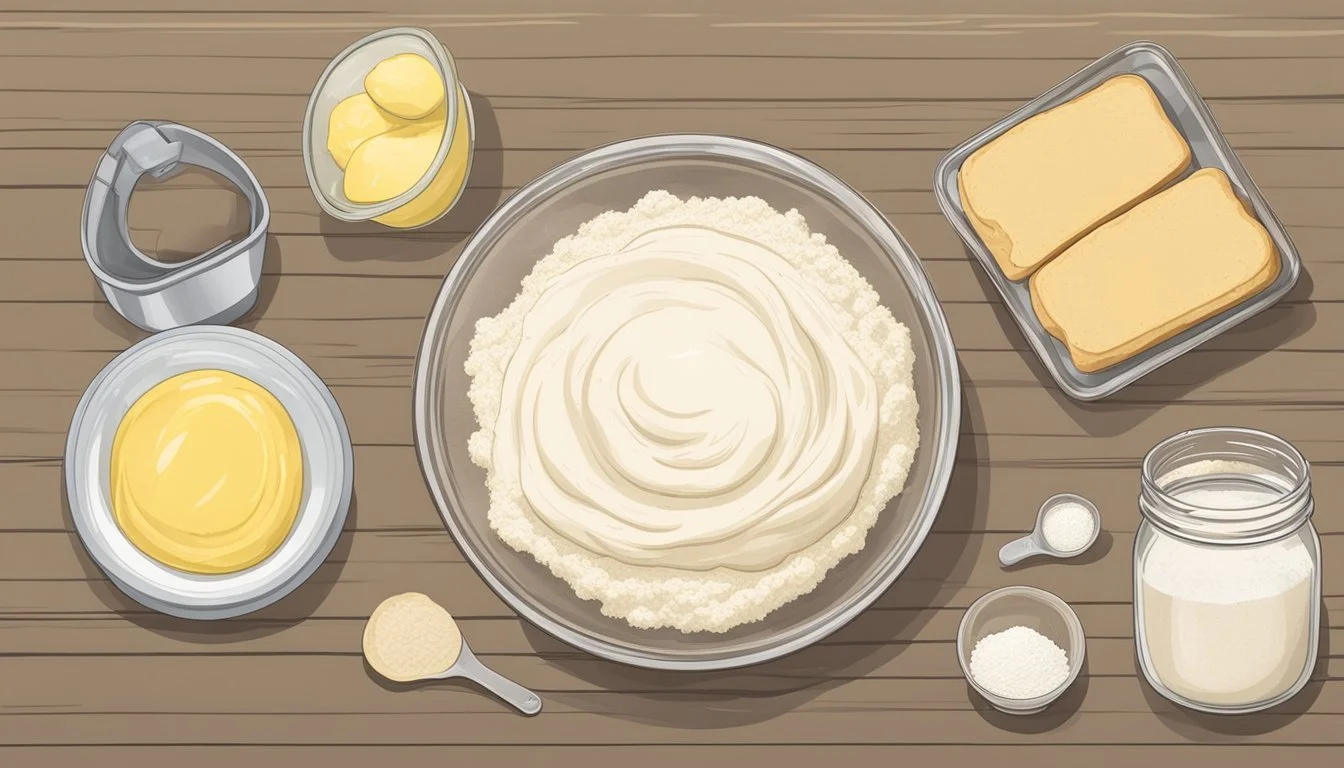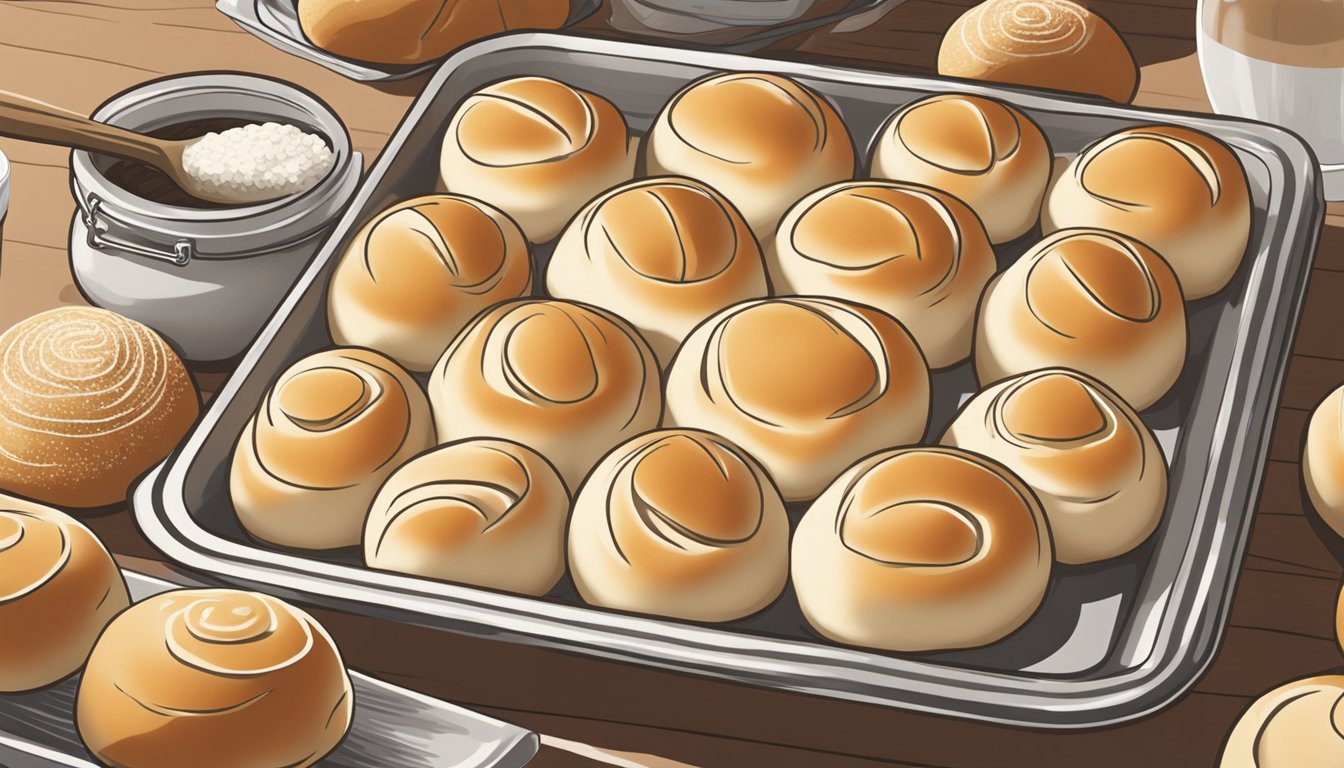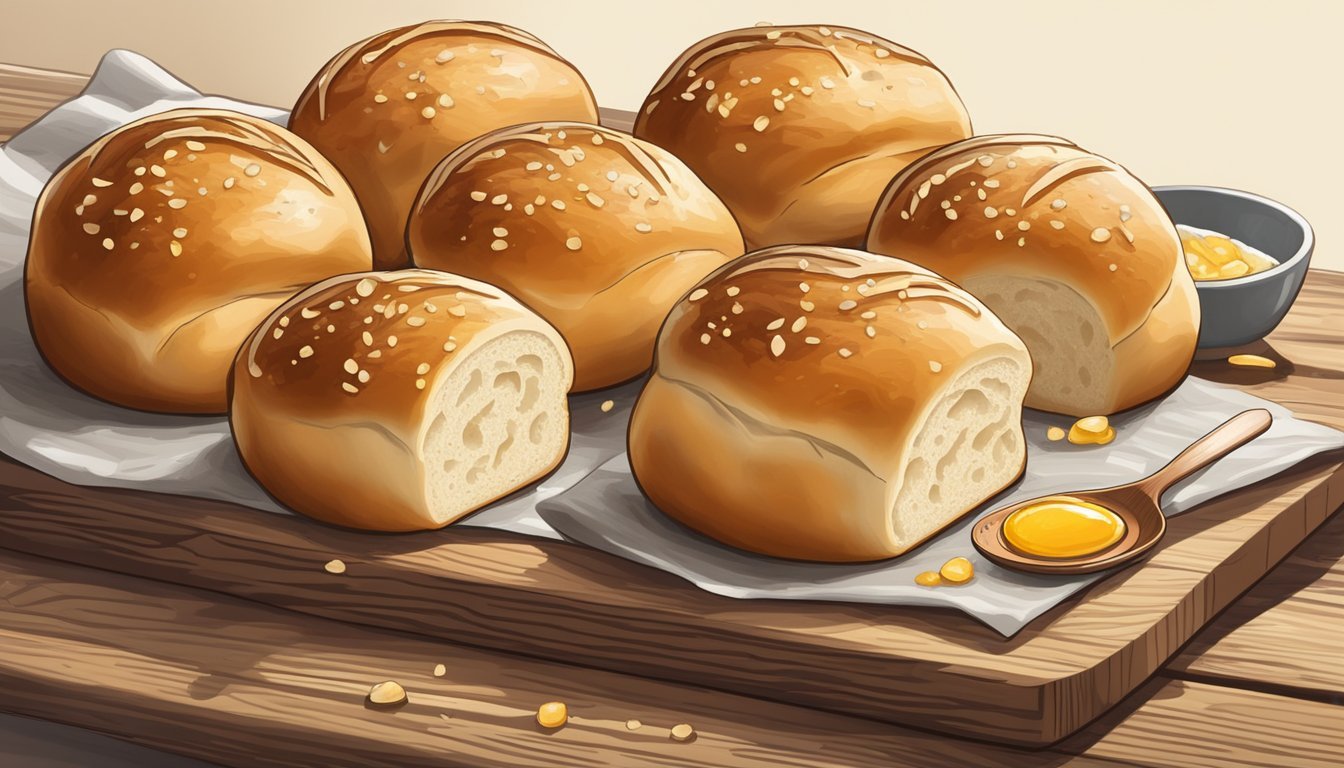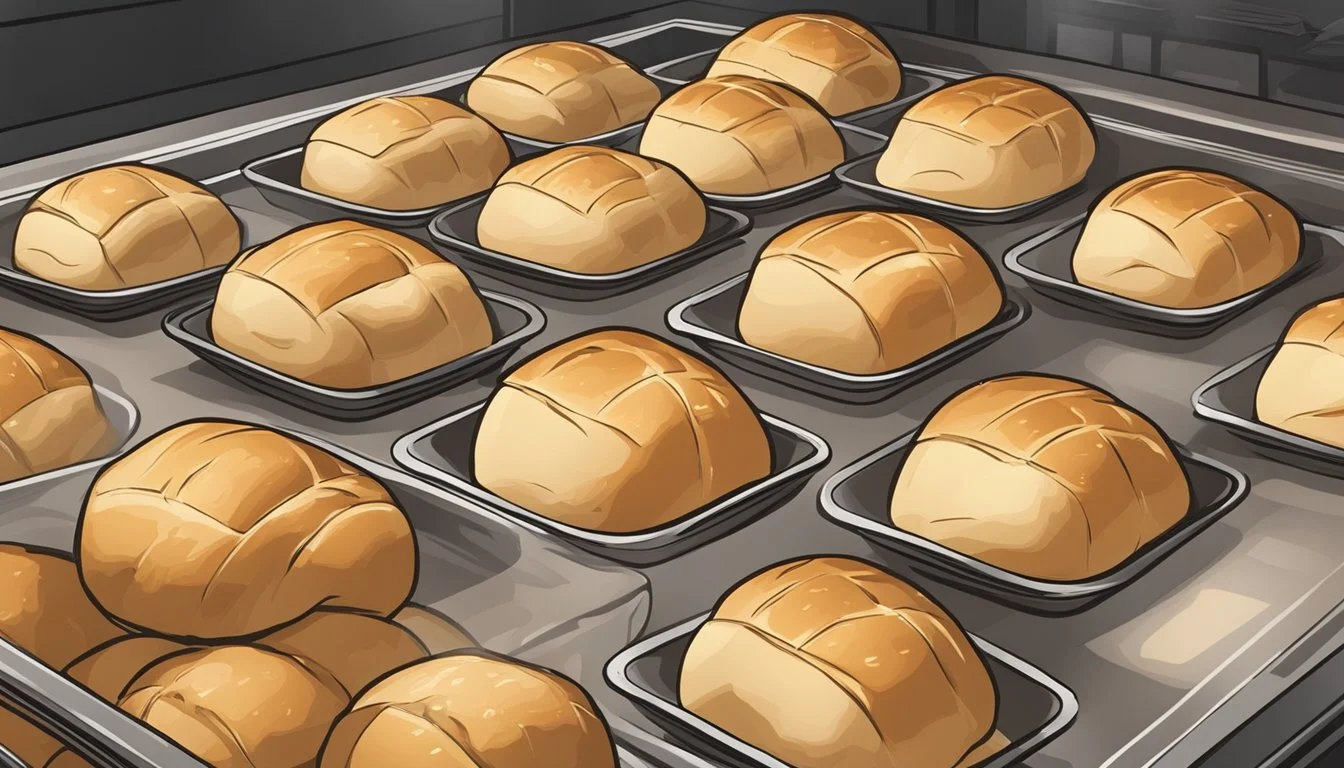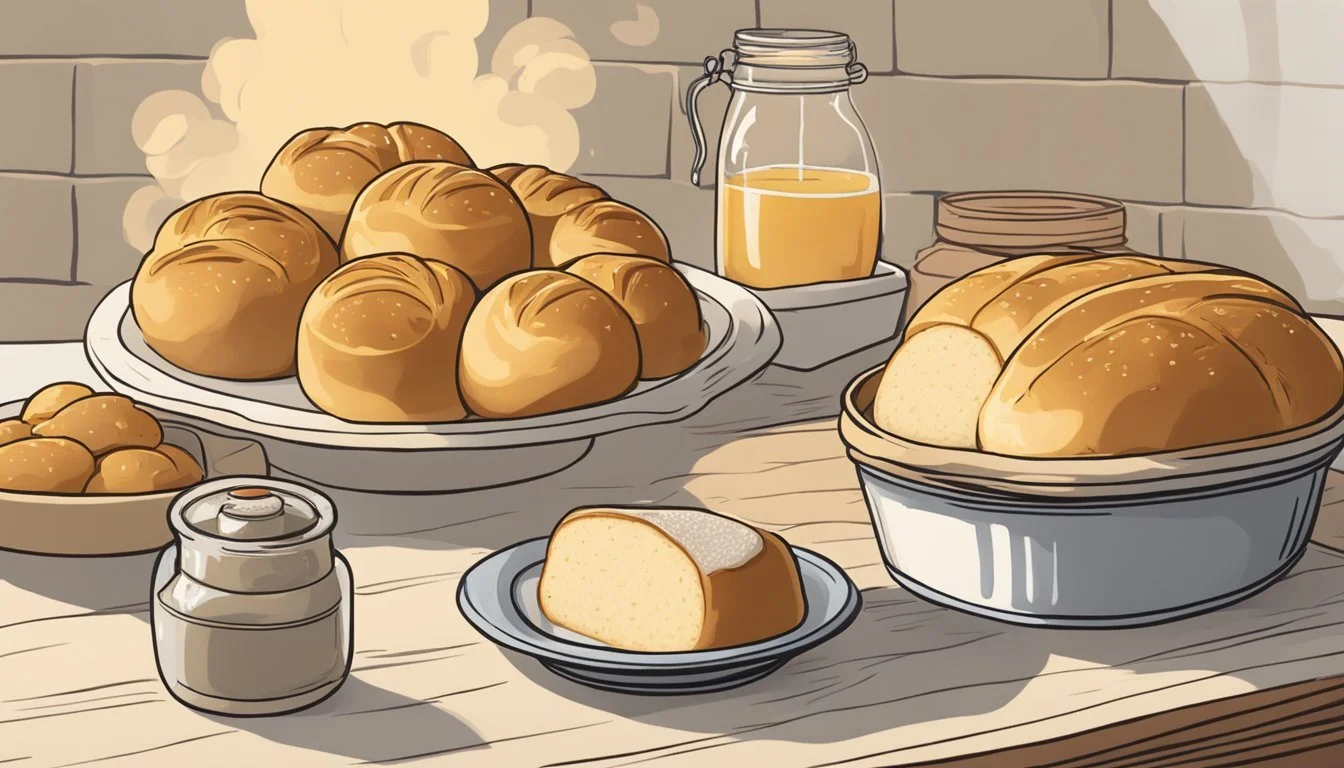Sourdough Dinner Rolls
The Perfect Combination of Softness, Butter, and Fermentation
Sourdough dinner (What wine goes well with dinner?) rolls are a delightful twist on the traditional bread roll, offering a unique combination of tangy fermentation flavors with a pillowy soft and buttery texture. These rolls embody the essence of sourdough baking, leveraging the natural leavening process that not only provides a depth of flavor but also imparts beneficial properties, as the fermentation can make the grains more digestible and nutritious. Catering to the modern palette that appreciates both artisanal quality and comfort food, sourdough rolls are versatile companions to a variety of meals.
Crafting sourdough dinner rolls begins with a matured sourdough starter—a mixture of flour and water that has been allowed to ferment and cultivate natural yeasts and bacteria. The process of incorporating this starter into the dough is what imparts the signature flavor and texture to the rolls. As the dough slowly ferments, the complexity of the flavors develops, leaving bakers with a dough that rises more naturally and offers subtle variations with each batch. Careful mixing, fermenting, and shaping techniques contribute to the final quality of these distinctive rolls, which can be enjoyed as a side to many dishes or savored on their own.
The allure of sourdough dinner rolls is in their simplicity and the satisfaction of creating something with time-honored methods. These rolls are not just about the ingredients—flour, water, salt, and starter—but also about the ritual and craft of baking. They represent a return to basics and a nod to traditional baking practices, all while fitting perfectly into the modern table setting. Whether slathered with butter, used to sop up savory sauces, or merely enjoyed fresh from the oven, sourdough dinner rolls are a testament to the beauty of artisan baking and the enduring appeal of well-made bread.
The Art of Sourdough Dinner Rolls
Sourdough dinner rolls epitomize the union of flavor and traditional fermentation techniques, yielding rolls with a distinctive tang characteristic of sourdough. It starts with the sourdough starter, a culture of wild yeast and lactobacilli. Through the art of long fermentation, the dough’s flavor and digestibility are enhanced, setting it apart from common dinner rolls.
Creating the Perfect Sourdough Starter:
A good sourdough dinner roll begins with a robust starter, which is a mix of flour and water left to ferment. Over time, it captures wild yeast and bacteria from the environment, which naturally leaven the bread and develop its sour taste.
Fermentation - Flavor's Ally:
First Stage: The starter is mixed with more flour and water, along with any additional ingredients such as butter for a soft texture. Here, patience is key as the dough undertakes its initial rise, often for several hours.
Stretch and Fold: This technique, performed several times during the initial rise, strengthens the dough’s gluten network without overworking it, contributing to a tender crumb.
Final Proofing:
Shaping the rolls is a delicate process, as one must balance maintaining the dough's structure with creating rolls of even size. It’s common to allow a final proof, which can be done overnight in a cool environment. This slow rise enhances the flavor complexity and ensures a light texture.
When ready, the rolls are typically brushed with an egg wash for a golden finish and perhaps a sprinkle of salt for contrast. A preheated oven then welcomes the dough, where it transforms into rolls with a soft, buttery interior and a slightly crispy crust. The artistry of sourdough dinner rolls lies not just in their preparation, but in their ability to bring the rich history of sourdough to the modern dinner table.
Choosing the Right Ingredients
Selecting high-quality ingredients is essential for creating soft, buttery sourdough dinner rolls. From the type of flour used to the choice of fats and liquids, each component contributes to the flavor, texture, and performance of the dough.
Flour Selection
The flour forms the foundation of sourdough dinner rolls. Bread flour is preferred due to its higher protein content, which ensures a chewy texture and structure. However, all-purpose flour can also be used, yielding a slightly softer roll. For more artisan rolls, one might consider organic or locally milled flour varieties for their unique flavor profiles.
Leveraging Sourdough Starter
A mature, well-fed sourdough starter is crucial for leavening and flavor. It imparts a tangy depth to the rolls and serves as a natural fermenting agent. The starter should be active, with a balance of yeast and bacteria, to achieve the desired rise and taste.
Fats for Flavor and Texture
Fats enrich the dough, contributing to the rolls' tender crumb and rich taste. Unsalted butter is often preferred as it allows control over the salt content, enhancing the subtle flavors within the rolls. For those who seek a richer flavor, high-quality European-style butter can be an option.
Liquids for Dough Hydration
Liquids are necessary to hydrate the flour and bring the dough together. Water is the standard liquid, but milk can be incorporated to tenderize the bread, add richness, and lend a gentle sweetness. It is pivotal to use liquids at the right temperature to activate the sourdough starter without hindering its activity.
Sweeteners and Salt Balance
Sugar adds a touch of sweetness and contributes to the golden crust of the rolls. Fine granulated sugar or honey are common options. Sea salt, preferably in a coarse form, is used not only to enhance flavor but also to regulate yeast activity. The salt should be well-measured to strike the perfect balance in the dough.
The Mixing and Kneading Process
The mixing and kneading process is crucial in developing the right texture in sourdough dinner rolls. Whether using a stand mixer or employing hand-kneading techniques, the goal is to achieve a smooth, elastic dough that will turn fluffy after baking.
Using a Stand Mixer Efficiently
A stand mixer is a valuable tool for consistently mixing sourdough dinner roll dough. It's important to start the mixer on a low speed to combine the ingredients without overworking the dough from the beginning. One should gradually increase the speed once the ingredients are incorporated to permit thorough kneading. A typical process might look like this:
Mix: Attach the paddle attachment and mix the starter, flour, and other ingredients at a low speed until just combined.
Knead: Switch to a dough hook and knead on a medium-low setting for about 5 to 7 minutes until the dough is smooth and pulls away from the sides of the mixing bowl.
Using a kitchen scale can enhance precision when measuring ingredients, leading to a more consistent dough.
One must monitor the dough, as over-kneading can lead to an overly dense roll, while under-kneading might not develop the structure needed for a fluffy texture.
Hand-Kneading Techniques
For those without a stand mixer, hand-kneading is an excellent alternative that also allows bakers to connect with the tactile experience of dough-making.
Prep: Begin by placing the dough on a lightly floured surface to prevent sticking.
Knead: Use the heels of your hands to press and stretch the dough, fold it back onto itself, then give it a quarter turn. Repeat for about 10 to 15 minutes.
Texture: The dough should be soft yet firm, and after sufficient kneading, it should feel springy and pass the windowpane test, indicating good gluten development.
A consistent kneading rhythm and sufficient time are key for achieving the right balance between elasticity and firmness in the dough. Patience during this step will ensure that the rolls are soft and properly fermented, which is essential to the final quality of sourdough dinner rolls.
Bulk Fermentation Essentials
The bulk fermentation stage is the period when the dough is allowed to rise after it has been mixed, and before shaping begins. This step is critical in sourdough baking as it develops the dough's flavor, structure, and strength. Essential to this process is a warm, stable environment, with the ideal dough temperature being around 78°F for optimal yeast and bacteria activity.
One should begin with an active sourdough starter; that is, a culture of flour and water teeming with wild yeast and bacteria. The strength of the starter can affect how long bulk fermentation takes. A common timeline for bulk ferment at a controlled temperature is approximately 4 to 4.5 hours. However, variables like ambient temperature and the quantity of starter used can alter this time frame.
It's important to note that sourdough discard, the portion of the starter that is removed prior to feeding, is typically not active enough for effective bulk fermentation. Instead, the discard can be used for other recipes that do not rely on it as the sole leavening agent.
For those preferring a slower fermentation to develop more complex flavors, an overnight rise can be employed. This involves letting the dough bulk ferment at a cooler temperature, which extends the process considerably. A cold proof is similar but occurs after shaping.
During bulk fermentation, the dough should double in volume. This increase in size is a visual cue that fermentation is progressing properly. Bakers often use this sign, along with other tests, to gauge when the dough is ready to be shaped. If a longer fermentation is desired, the process can be slowed down by placing the dough in a cooler environment.
Remember to cover the dough with a damp cloth or plastic wrap during this stage to prevent the surface from drying out. This ensures that the dough retains the necessary moisture to rise adequately.
Shaping the Perfect Roll
Crafting the perfect sourdough dinner roll requires attention to detail during shaping. To ensure consistency in taste and texture, proper portioning, forming, and setting up for the second rise are crucial steps.
The Role of Portioning
To achieve uniform rolls, one must divide the dough into equal parts. It's typically recommended to use a digital scale to portion the dough into sections of the desired weight—this ensures that they bake evenly and no roll is left under or overcooked.
Weighing: Aim for portions between 70 to 100 grams for standard-sized rolls.
Consistency: Equal-sized dough portions contribute to a consistent baking process.
Crafting the Ideal Form
With the dough portioned, shaping begins by folding the cut pieces into taut, round balls. The taut surface helps in the formation of a roll that is light and airy.
Tight Surface: Gently pull the dough across a clean work surface to create tension on the top, pinching the seams at the bottom.
Ball Shape: Each piece should be rolled into a smooth, tight ball to help the rolls maintain their form during proofing and baking.
Preparing for the Second Rise
Once shaped, the rolls must undergo a second rise, which allows the fermentation process to continue until doubled in size. This step is pivotal as it affects the final texture and taste of the rolls.
Proofing Environment: Place the rolls on a baking sheet lined with parchment paper to prevent sticking. Space the rolls a few inches apart to allow for expansion.
Covering: To keep the dough from drying out, lightly cover the rolls with plastic wrap or a damp towel.
Second Rise: Allow the rolls to proof in a warm area until puffy and nearly doubled in size. This can take anywhere from 30 minutes to several hours, depending on the vigor of the starter and room temperature.
Baking Techniques for Optimal Results
Crafting sourdough dinner rolls that are soft, buttery, and beautifully fermented can be achieved with precise baking techniques. This section outlines two fundamental aspects: setting the right oven temperature and achieving a golden brown crust, both of which are critical to the success of the bake.
Setting the Right Oven Temperature
The oven temperature is a pivotal factor in baking sourdough dinner rolls. Bakers should preheat their oven to 350°F (177°C). This specific temperature ensures that the rolls bake evenly and develop a soft interior without overcooking the outside. It's important to use an oven thermometer to verify the accuracy of the oven's readings, as fluctuating or incorrect temperatures can result in under or overbaked rolls.
Preheat: 350°F (177°C)
Consistency: Check oven temperature with a thermometer
Achieving a Golden Brown Crust
A golden brown crust not only adds visual appeal but also texture to sourdough dinner rolls. Attaining this requires a few steps:
Egg Wash: An egg wash (1 egg beaten with 1 tablespoon of water) brushed onto the surface of the rolls before baking helps achieve a glossy, golden crust.
Baking Dish: Rolls should be placed evenly spaced in a baking dish to allow for uniform heat distribution. They can be baked in either round or square baking pans, providing they fit comfortably and are not overcrowded.
Monitoring: Watch the rolls during the final minutes of baking. If they start to over-brown, they can be covered loosely with aluminum foil to prevent further darkening of the crust.
Egg Wash: 1 beaten egg + 1 tbsp water
Brushing: Gently brush the egg wash onto the rolls
Baking Sheet/Dish: Space rolls evenly for uniform baking
Final Minutes: Watch closely and cover with foil if over-browning occurs
By adhering to these specific baking techniques, bakers will set themselves up for optimal results, producing sourdough dinner rolls that are well-fermented, soft, and delectable, with a perfectly golden crust every time.
Finishing Touches and Presentation
Once the sourdough dinner rolls have finished baking, they should display a golden-brown exterior while retaining a soft, fluffy interior. To elevate their appearance and flavor as they cool, a brush of melted butter over the rolls not only adds a glistening sheen but also a layer of rich, buttery flavor that is both comforting and appealing. The rolls should be presented on the dinner table in such a way that emphasizes their artisan quality.
When serving soft sourdough rolls, it is crucial to maintain their warmth, as this characteristic greatly enhances their taste and texture. A basket lined with a clean, decorative cloth holds the warmth and allows for a charming presentation. Upon serving, one could provide a side of softened butter, allowing guests to add an extra touch of richness if they choose.
For pull-apart dinner rolls, arranging them just touching enhances the experience, as guests can enjoy the satisfaction of pulling them apart to reveal the steamy, tender crumb inside. This style of presentation emphasizes the communal and shareable aspect of the rolls and makes for an interactive experience at the dining table.
Bakers should aim to have the rolls ready and prominently displayed as part of any meal, complementing the mains with their buttery allure. The sourdough's subtle tang pairs well with a variety of dishes and enhances the overall culinary experience. By paying attention to these finishing touches and presentation, one elevates simple sourdough rolls to an inviting and appetizing item on the dinner menu.
Seasonal Adaptations and Variations
Sourdough dinner rolls can delightfully embody the essence of each season with minor adjustments to their traditional recipe. Each tweak can transform these baked goods to fit a holiday theme or seasonal preference.
Thanksgiving brings warmth and spices to the forefront. Incorporating a hint of garlic into the dough adds a rich, savory layer that complements traditional dishes like turkey and stuffing. Alternatively, bakers might opt to garnish rolls with seeds or nuts for added texture and a festive appearance.
During the Christmas season, dinner rolls can embrace the holiday spirit by incorporating subtle spices such as cinnamon or nutmeg into the dough. This can create a unique twist reminiscent of cinnamon rolls, to be served as a sweet treat or enjoyed with a savory meal. For a decorative touch, these rolls can be shaped into festive forms such as wreaths or Christmas trees.
As Easter heralds the arrival of spring, lighter versions of sourdough rolls can be made using milk bread formulas. Incorporating milk into the dough creates a softer, fluffier texture, which is perfect for a light Easter brunch. A touch of citrus zest, like orange or lemon, adds a refreshing note suitable for the season.
Lastly, sourdough's versatility extends beyond dinner rolls. Sourdough bagels can be a year-round staple that adjust to the seasons with different toppings: pumpkin seeds in fall or festive colored sprinkles for holidays.
Season Adaptation Variation Fall Garlic-infused dough Pumpkin seed-topped sourdough bagels Winter Spiced dough (cinnamon, nutmeg) Christmas tree-shaped rolls Spring Milk bread rolls with citrus zest Light, fluffy texture perfect for Easter brunch
These adaptations inject a delightful seasonal twist to traditional sourdough dinner rolls, making them versatile mainstays for any festive table.
Complementing Dishes and Pairings
Sourdough dinner rolls, with their distinct tang and pillowy texture, are versatile accompaniments for an array of meals. They complement both complex and simple flavors, making them suitable for various dishes.
Grains
Whole grains like quinoa, barley, or wild rice offer a nutty, earthy counterpoint to the sourdough's tangy profile. A bowl of grain salad paired with a buttery sourdough roll can balance the meal with satisfying textures.
Soups and Stews
Chunky vegetable soups or rich, hearty stews are ideal partners for sourdough rolls. Their ability to soak up broths makes them a fitting choice for dishes like beef bourguignon (What wine goes well with beef bourguignon?) or a creamy potato leek soup.
Savory Fillings
Transform a sourdough roll into a slider or mini sandwich with savory fillings. Consider classics like pulled pork or mini hamburgers, with the rolls serving as delectable burger buns, absorbing flavors and sauces with ease.
Suggested Pairings:
Dish Type Suggested Pairing Grain Salads Sourdough Roll with a light spread of herbed butter Hearty Stews Side of a warm sourdough roll Casual Sandwiches Mini sliders with sourdough rolls as hamburger buns
For vegetarian options, a tangy sourdough roll complements the creaminess of roasted vegetable soups. Hearty lentil stews also work beautifully, creating a comforting and nourishing meal. Whether one is serving a simple weeknight dinner or hosting a gathering, sourdough dinner rolls can elevate the experience, pairing perfectly with a multitude of dishes.
Storing and Reheating for Freshness
Properly storing and reheating sourdough dinner rolls can preserve their fresh taste and soft texture. Leftover rolls can remain good for up to 4 days when stored at room temperature in a plastic bag or wrapped in plastic wrap to prevent them from drying out.
Freezing is an excellent option for keeping sourdough rolls fresh longer. To freeze, one should:
Let the rolls cool completely on a wire rack.
Wrap them individually in plastic wrap.
Place the wrapped rolls in a freezer bag, removing as much air as possible.
They can be stored in the freezer for up to 3 months.
When it comes to reheating, removing the rolls from the freezer and allowing them to defrost at room temperature is the first step. Preheat the oven to 350°F. If they are still wrapped, they can be placed directly on an oven rack or on a baking sheet. If not, it's recommended to wrap them in foil before reheating to prevent them from drying out or burning. It typically takes about 10 minutes for the rolls to warm up thoroughly.
To ensure moisture retention, some prefer to brush the rolls with melted butter before placing them in the oven, which can enhance their flavor and give them a nice, golden finish. A checked internal temperature of 110°F ensures the rolls are warm all the way through without overcooking them.
Remember, reheating times may vary slightly depending on the oven and the size of the rolls, so keeping an eye on them is advised.
Advanced Tips for Sourdough Enthusiasts
When it comes to crafting the perfect sourdough dinner rolls, enthusiasts know the devil is in the details. Utilizing both commercial yeast and an active sourdough starter can give one control over the leavening process. While purely wild yeast from an established starter imparts a traditional tang and complex flavor, the addition of a small amount of commercial yeast can ensure a consistent rise and is particularly useful in colder temperatures where wild yeast may be less active.
Optimizing the Starter: For sourdough dinner rolls, the starter should be in its peak state. This means it should be doubled or tripled in volume, with a dome-shaped top that is just beginning to show signs of receding.
Hydration of the Starter: A 100% hydration starter (equal parts flour and water by weight) is typically used for rolls, but adjustments can be made for a wetter dough that may yield softer rolls.
Implementing Sourdough Discard: Discarded sourdough (the portion removed when feeding the starter) can be an excellent addition to dinner roll recipes. It adds depth of flavor without the leavening power, ideal for more delicate textures.
Incorporation Technique: When using discard, one might want to increase the stretch and fold technique to develop the dough's strength without overworking it.
Managing Bulk Fermentation: During the bulk rise, aim for the dough to increase by 50-100% in volume. Ambient temperature plays a critical role and should be monitored for consistency.
Ambient temperature Expected bulk rise time 70°F (21°C) 6-8 hours 75°F (24°C) 4-6 hours
Shaping and Proofing: An intricate step is dividing the dough into even portions and shaping them tightly to create surface tension, which helps in achieving a rise that is both upward and outward.
Final Rise: Optionally, one can cover and cold proof the shaped rolls overnight to further develop the flavor and structure.
In summary, enthusiasts should heed the unique properties of wild yeast, consider the roles of commercial yeast and sourdough discard, perfect their kneading and folding techniques, and tightly regulate environmental factors for impeccable sourdough dinner rolls.
Common Questions About Sourdough Rolls
Sourdough rolls can challenge even seasoned bakers with their unique fermentation process and dough consistency. Grasping these concepts aids in producing the perfect batch of soft, buttery rolls.
Troubleshooting Dough Consistency
A common issue bakers face with sourdough roll recipes is achieving the right dough consistency. It should be tacky but not overwhelmingly sticky. If the dough is too wet, one may incorporate small amounts of flour during kneading; however, adding too much flour can result in dense rolls. Conversely, if the dough is too dry, adding a bit of water can help. It's crucial to do this gradually and to allow the dough to absorb the additions completely before deciding if more adjustments are needed.
Understanding Dough Proofing Times
The bulk fermentation and proofing times are critical stages in sourdough roll making. These processes can vary greatly based on room temperature and the activity level of the sourdough starter. Generally, one can expect the bulk fermentation to take around 4 to 6 hours. During this time, the dough should roughly double in size. Using an instant-read thermometer can help determine the dough's readiness, usually around 75°F to 78°F (24°C to 26°C).
Proofing can be done overnight in the fridge, which slows fermentation and can enhance flavor development. Dough shaped into rolls will need a final proofing, often around 1 to 2 hours at room temperature, which is when they’re ready to be baked. A good indicator of proper proofing is the dough filling out the pan and being puffy to the touch. It's imperative to keep an eye on the dough and adjust proofing times as needed to ensure a light and airy texture in the finished rolls.
Conclusion: Embracing the Sourdough Journey
When one decides to venture into the world of sourdough dinner rolls, they embrace a process that marries tradition with patience. These homemade dinner rolls are not just a testament to the baker's skill but also to their dedication to crafting a product that boasts a rich, tangy flavor and a soft, buttery texture.
Sourdough dinner rolls stand out from their counterparts due to their unique fermentation process. The presence of natural yeast and bacteria in the sourdough starter contributes to the development of these rolls' characteristic taste and texture. Successful execution of a sourdough dinner roll recipe requires attention to detail, from the initial knead to the final bake.
Preparation: A baker must start with a lively sourdough starter to impart the distinctive tangy flavor.
Kneading: Less is more, as the dough develops strength and elasticity with minimal intervention.
Fermentation: Patience is key, as a long fermentation period allows flavors to deepen.
Baking: The baker's skill shines in the oven where the perfect crust and crumb are achieved.
Embarking on this sourdough journey rewards bakers with rolls that are not only a pleasure to consume but also a mark of their expertise in the world of artisan baking. They master the subtle balance of flavor and technique, resulting in a baked good that is enjoyed by many and mastered by few. The journey may be intricate, but it is ultimately fulfilling, as each batch yields a sense of accomplishment alongside delicious sourdough dinner rolls.
Appendix: Sourdough Dinner Rolls Recipe
Preparing sourdough dinner rolls requires patience due to the fermentation process, but the resulting rolls are soft, buttery, and carry the unique tang of sourdough.
Ingredients:
Sourdough Starter: 1.5 cups (active)
All-Purpose Flour: 5-6 cups
Milk: 2.5 cups
Unsalted Butter: 1/2 cup (softened)
Sugar: 1/3 cup
Salt, Rosemary, Garlic (optional): to taste
Method:
Prepare Sourdough Starter: The night before baking, feed the sourdough starter. Ensure it's active and bubbly.
Mix Ingredients:
In a stand mixer, cream the softened butter and sugar.
Add the active sourdough starter and milk, then mix.
Gradually incorporate 5 cups of flour. Adjust with more flour as needed to achieve a soft, but not overly sticky dough.
First Rise:
Transfer the dough to a bowl, cover with a damp cloth or plastic wrap.
Let the dough rise overnight at room temperature. It should double in size.
Shape Rolls:
Divide the dough into equal portions. Shape into tight balls for individual rolls.
Second Rise:
Place the shaped rolls into a baking pan.
Cover with plastic wrap and let them rise until they've puffed up, usually taking another 4 to 6 hours.
Bake the Rolls:
Preheat the oven.
Bake the rolls until they're golden brown on top.
Optional: Brush with melted butter for a shinier finish after baking.
One can choose to incorporate seasonings like rosemary or garlic for an added flavor profile, as suggested in various online recipes. The richness of the rolls comes from the milk and butter in the dough, ensuring that the final product has a soft texture and a delectable buttery flavor.


